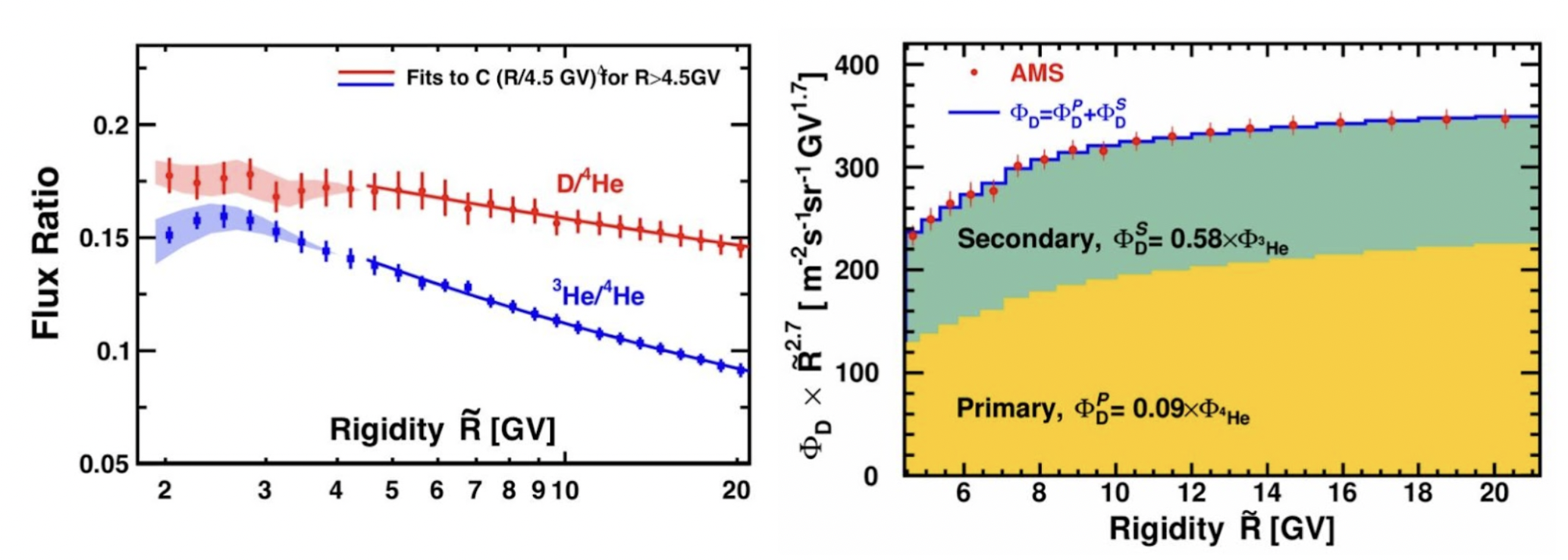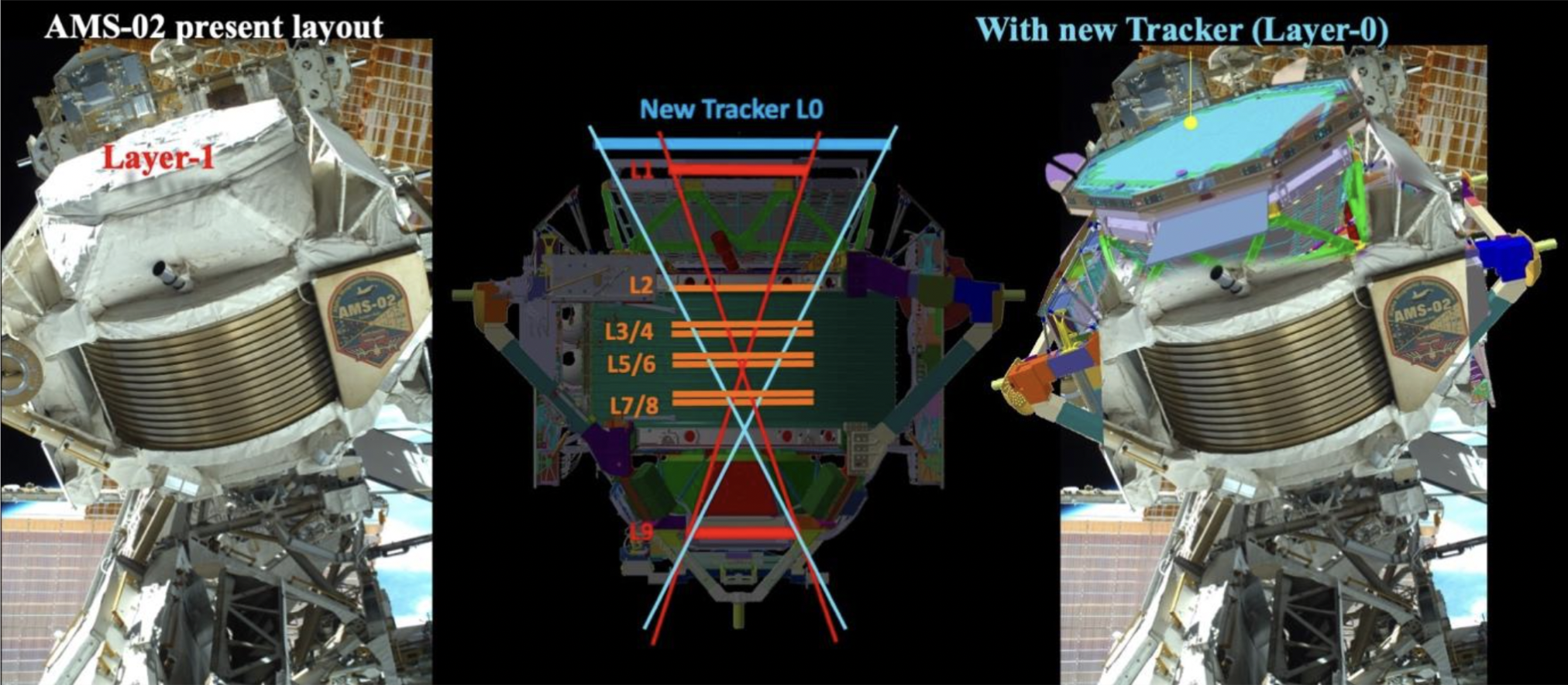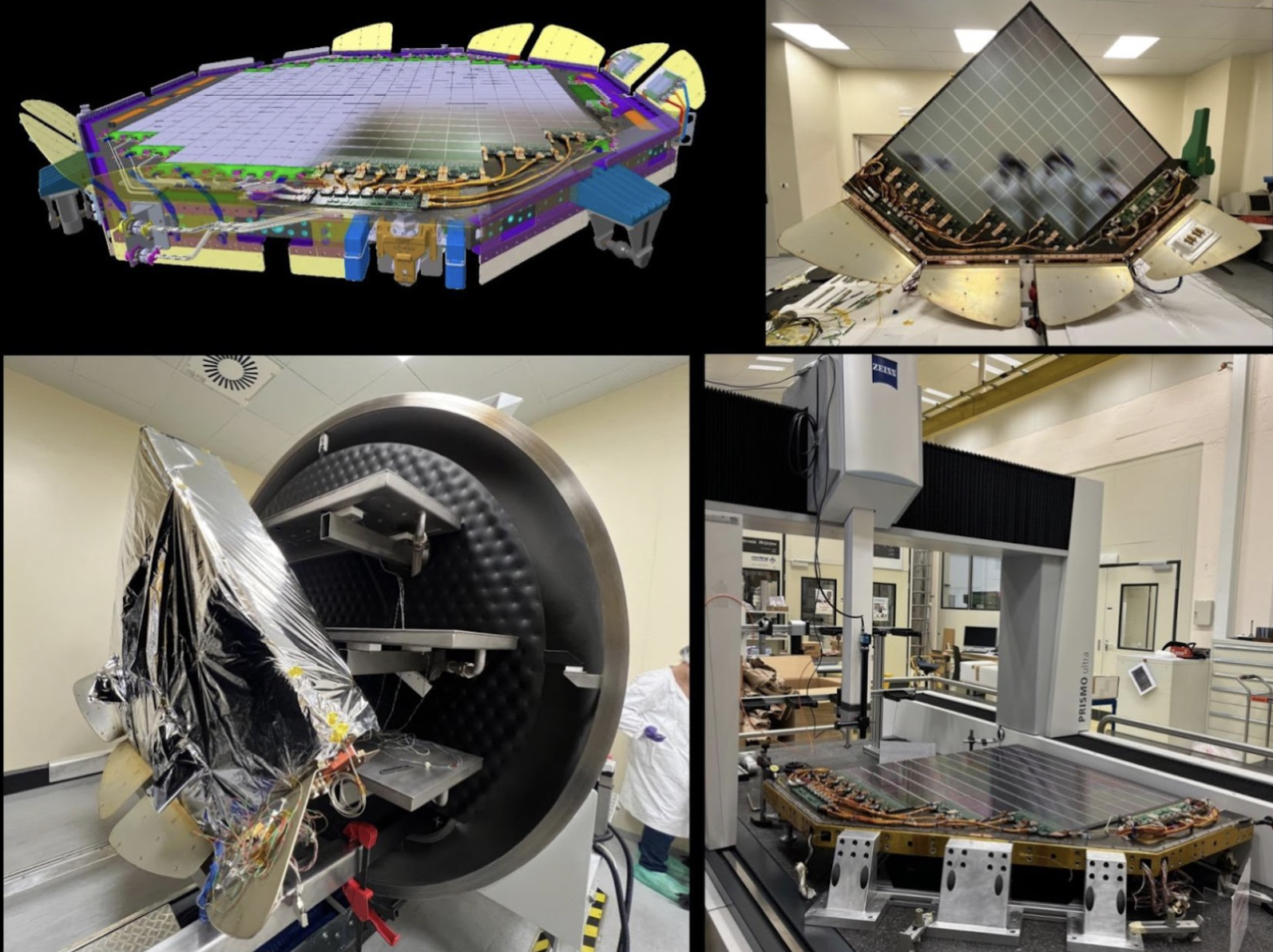Highlights from the Alpha Magnetic Spectrometer on the International Space Station

The Alpha Magnetic Spectrometer, AMS, is a high-energy particle detector performing unprecedented-precision measurements of cosmic rays of rigidity (momentum/charge) ranging from GV to 3 TV on the International Space Station (ISS). AMS has now reached 13 years of continuous operation, and it has collected well over 235 billion cosmic-ray events. It will continue acquiring data for the entire ISS lifetime through 2030 and beyond.
AMS is the largest magnetic spectrometer ever deployed in space. It combines five detectors: Time of Flight (TOF) and Anti-Coincidence Counters, a Transition Radiation Detector (TRD), nine layers of Silicon Tracker, layer L1 at the top of the instrument, layers L2-L8 inserted in the bore of a permanent Magnet, and layer L9 at the bottom, a Ring Imaging Cerenkov (RICH) and an Electromagnetic Calorimeter (ECAL). They provide redundant measurements of the particle’s charge along its trajectory inside the apparatus, and independent measurements of the particle’s rigidity, velocity, and energy.
The silicon tracker measures the rigidity and charge sign from the track’s bending inside the magnetic field. The two TOF layers and the RICH determine the particle’s velocity at percent and permille accuracy, respectively. Combined to the rigidity measurement, these provide isotope identification of light nuclei of rigidity up to tens of GV. The ECAL measures the energy of electrons and positrons with percent accuracy. Identification of leptons against hadrons with a rejection power of 1/105 is achieved, combining the ECAL 3D shower reconstruction with the TRD response.
Cosmic rays are energetic particles of energies ranging from the MeV to 1020eV. Their properties are studied from measurements of their energy (or rigidity) spectra, that is the number of particles per unit time, solid angle, surface, and energy (or rigidity), as functions of energy (or rigidity). They are characterized by spectra that are rapidly decreasing with increasing energy. Cosmic rays of energy below the PeV are thought to originate in our galaxy.
The elemental composition of galactic cosmic rays is dominated by hydrogen nuclei, mainly protons. Helium nuclei account for about 10%, electrons, and nuclei heavier than helium account for only 1% each. The abundances of positrons and antiprotons relative to protons are only about 1/1000 and 1/10’000 respectively. The abundance of each species is determined by their main production mechanism. Species synthesized in stars, such as protons, electrons, and most of the nuclei, are called primary cosmic rays. Light nuclei which can be synthesized by nuclear fusion in the core of stars are more abundant than heavier nuclei, as their production becomes less energetically favourable as mass increases. Synthesis of nuclei heavier than iron, such as nickel, proceeds through explosive phenomena, such as supernova explosions occurring at the end of the life of massive stars. This makes nuclei beyond iron very rare. Primary nuclei, once emitted by their sources in outer space, might collide with the interstellar medium and fragment in lighter species. This is the main production mechanism of nuclei such as lithium, beryllium, boron, fluorine, scandium, titanium, and vanadium whose production through stellar nucleosynthesis is energetically disfavoured. They are called secondary cosmic rays. Compared to primary nuclei of similar mass, secondary nuclei are less abundant and have rigidity spectra decreasing faster than the spectra of primaries as rigidity increases. The energy (or rigidity) dependence of cosmic-ray spectra results from the combination of emission from their sources, acceleration, and propagation mechanisms occurring while cosmic rays travel through the galaxy. Cosmic rays are accelerated by diffusing through expanding shocks and propagate diffusively in the interstellar medium, scattering on the irregularities of the galactic magnetic field. Both these mechanisms depend on the particle’s momentum, or magnetic rigidity. Cosmic-ray propagation is described in terms of a rigidity-dependent diffusion coefficient, which embeds the properties of the galactic magnetic field turbulence. Simultaneous measurements of the individual rigidity spectra of secondary species and their primary progenitors, such as 3He/4He, B/C, B/O, F/Si, or Sc/Fe, are the key experimental tools to probe cosmic-ray propagation as their ratio directly maps the rigidity dependence of the diffusion coefficient.
Current models assume that all primary nuclei have identical featureless power-law rigidity spectra, and that the diffusion coefficient follows a featureless power law in rigidity, and it is independent of the particle’s charge, leading to identical featureless power-law spectra for all secondary nuclei. This paradigm is being challenged by the AMS experiment which is providing the most precise and comprehensive dataset of specie-resolved spectra of cosmic rays, including energy spectra of electrons and positrons, rigidity spectra of protons, antiprotons, nuclei from helium to silicon, sulfur, and iron, and helium isotopes. The AMS results are revolutionizing our understanding of cosmic-ray physics, as demonstrated by the more than 7000 citations of the 27 articles published by AMS so far in Physical Review Letters. Furthermore, 14 of these 27 articles were chosen as Editor's suggestions, and 5 featured in the Physics magazine for their quality, broad scientific interest, and high impact. The AMS measurements have revealed spectral features around 200 GV in all nuclei spectra, as well as in secondary-to primary ratios. Moreover, AMS has observed two classes of primary and secondary nuclei, each characterized by a distinct spectral shape, with light secondary-to-primary ratios, such as B/C and B/O, exhibiting different rigidity dependence than the heavy secondary-to primary ratio F/Si. The Sun’s magnetic field strength varies on an 11-year cycle, the field lines rearrange with the field polarity reversing every 11 years. The emanation of the Sun’s magnetic field in the solar neighbourhood creates a sort of magnetic bubble called the heliosphere, which affects the propagation of cosmic rays from the outer interstellar space to near-Earth. Consequently, at low rigidities, cosmic ray spectra measured inside the heliosphere are modulated by the Sun’s magnetic field and their shape depends on time. With its long-duration mission, covering more than an entire solar cycle, AMS is also studying the propagation of cosmic rays in the changing heliosphere by measuring monthly electron and positron spectra, and daily proton and helium nuclei spectra.
The AMS results on daily proton and helium, and on primary and secondary nuclei have been described in previous articles published at CERN EP newsletter (HERE & HERE). Recently, AMS has published measurements of daily electron and positron fluxes, which reveal new information on how the Sun’s magnetic field influence the propagation of particles of opposite sign. AMS has found that electron fluxes show distinctly different time variations from the proton fluxes, observing a hysteresis between the electron flux and the proton flux with a significance greater than 6𝜎 at rigidities below 8.5 GV [1].
AMS has also observed distinctly different time variations of positron fluxes with respect to the electron fluxes at short and long timescales, and a hysteresis with a significance greater than 5𝜎 at rigidities below 8.5 GV. On the contrary, the positron fluxes and the proton fluxes show similar time variation, but with positron fluxes more modulated than protons [2]. The results on positrons, when studied together with the result on daily protons and helium, allow comparing particles of the same charge and different velocities and to study mass-dependent effects in the propagation of cosmic rays in the heliosphere. These time-resolved AMS measurements provide an invaluable dataset for studying how galactic cosmic rays propagate in the turbulent heliosphere.

Figure 1: AMS daily electron fluxes for four rigidity bins from 1.00 to 11.0 GV measured from May 2011 to November 2021 covering the ascending phase, the maximum, and descending phase to the minimum of solar cycle 24, and part of the ascending phase of solar cycle 25 (top left). Electron flux as function of the proton flux, both calculated with a moving average of about 14 months with one day step (top right) for one characteristic rigidity bin. Positron flux as a function of the electron flux (bottom left) and as a function of the proton flux (bottom right), all calculated with a moving average of about 14 months with a three-day step. Different colours highlight data for different years. Hysteresis between the electron and proton fluxes and between electron and positron fluxes are observed before and after the solar maximum in 2014. All fluxes peak in 2020, after which the hysteresis curve starts to trace the earlier behaviour (2018–2020) backwards.
The latest AMS results on the cosmic deuteron flux have revealed yet another surprise. Most cosmic nuclei are a mixture of two or more isotopes having different origin. As an example, He nuclei are composed of primary 4He and secondary 3He. Similarly, hydrogen nuclei are composed of about 98% protons, which are primaries, and about 2% deuterons (D). Deuterons in cosmic rays are thought to be pure secondaries produced by collisions of primary 4He with nuclei in the interstellar medium such as 3He. As they share the same progenitor, the D and 3He spectra are expected to have the same rigidity dependence and consequently, the secondary-to-primary ratios 3He/4He and D/4He are expected to be similar. The AMS The collaboration has carried out an unprecedented measurement of the deuteron flux, including measurements of solar modulation effects on deuteron, proton, 3He, and 4He fluxes. AMS has observed that, contrary to expectations, the rigidity dependences of the D/4He and the 3He/4He fluxes ratios are distinctly different above 4.5 GV, where they are not any more affected by solar modulation. Moreover, AMS has found that above 13 GV, the deuteron spectrum is nearly identical to the spectrum of the primary proton. These surprising observations can be explained by the presence of a primary component in the deuteron spectrum. Using a model-independent method developed by the AMS Collaboration to quantify primary and secondary components in spectra of cosmic-ray nuclei, the secondary and primary components in the deuteron spectrum have been quantified to be 0.58 times the 3He spectrum, and 0.09 the 4He spectrum respectively [3].

Figure 2: Left: AMS time-averaged deuteron to 4He (red circles) and 3He to 4He (blue squares) flux ratios as functions of rigidity. Shaded areas show corresponding flux ratio time variations at low rigidities below 4.5 GV. The red and blue solid lines are power law fits C (R/4.5 GV) ∆ for R > 4.5 GV to the D/4He and 3He/4He flux ratios respectively, yielding spectral indices ∆D/4He > ∆3He/4He with significance exceeding 10σ. Right : The AMS time-averaged deuteron flux (red points) above 4.5 GV is well fit with a linear combination of a primary component and a secondary component proportional to the 4He and 3He respectively. The yellow and green shaded areas represent the contributions of the primary and secondary components, respectively.
Credit: AMS Collaboration Phys. Rev. Lett. 132, 261001 (2024) https://doi.org/10.1103/PhysRevLett.132.261001
In parallel to the data analysis activities, the AMS Collaboration is preparing the upgrade of the detector to install an additional layer of silicon micro-strip tracker, L0, at the top of the instrument. The Layer L0 will add another 3D position and charge measurement point at the top of the instrument. This will increase the current AMS detector acceptance by 300%, allowing AMS to measure the spectra of the rarest nuclei in cosmic rays, namely the secondary nuclei scandium, titanium, and vanadium originated from the collision of iron nuclei with the interstellar medium, with accuracy comparable to the lighter secondary nuclei it has already published. These measurements are of fundamental importance to understand current AMS observations on differences among light and heavy nuclei and to build a comprehensive cosmic-ray propagation model. The upgrade will also allow AMS to improve the accuracy of the measurements of the electron and positron spectra beyond at TeV energies.

Figure 3: Current AMS layout on the International Space Station (left), schematic view of the upgraded detector with the addition of a new tracker layer at the top of the instrument which will increase the detector acceptance by 300% (center), and synthesized picture showing AMS in space after the upgrade in January 2026.

Figure 4: Progress of construction and tests of the new tracker layer L0. Top: the completed L0 quarter plane with its petal radiators (left) and image synthesis within the full plane (right). Bottom: The quarter plane at the thermo-vacuum test at the SERMS Laboratories in Terni, Italy, (left), and during metrology measurements at CERN (right).
The construction of the detectors for the new tracker layer L0 and the new power distribution supply (PDS) radiator for heat evacuation is progressing well according to the schedule in China and in Taiwan respectively, with 10 m2 of silicon detectors assembled and tested at IHEP in Beijing. A quarter plane has been assembled in Italy by INFN Perugia personnel, and has undergone space qualification tests, vibration, and thermo-vacuum tests at the SERMS Laboratories in Terni (Italy). In addition, radiation hardness tests have been carried out on the electronic components by a team of MIT scientists at Brookhaven. Metrology measurements on the quarter plane have been carried out at CERN. Single detector units have also been tested at particle beams at the CERN SPS last May 2024. The results from these measurements are being integrated in the AMS software simulation for physics studies of the upgraded detector. From May 22 to May 24 the AMS collaboration and the NASA personnel involved in the preparation and installation of the upgrade have gathered at CERN in one of the many interchange meetings that are being held regularly to coordinate the activities of the two teams in view of the implementation of the AMS upgrade in early 2026. These include four Extra-Vehicular Activities to get everything ready for the arrival of the new Tracker L0 and the PDS radiator with the SpaceX-33 flight in January 2026.
References
[1] AMS Collaboration, Temporal Structures in Electron Spectra and Charge Sign Effects in Galactic Cosmic Rays. Phys. Rev. Lett. 130, 161001 (2023) Editor’s Suggestion and Viewpoint in Physics https://doi.org/10.1103/PhysRevLett.130.161001
[2] AMS Collaboration, Temporal Structures in Positron Spectra and Charge-Sign Effects in Galactic Cosmic Rays Phys. Rev. Lett. 131, 151002 (2023) https://doi.org/10.1103/PhysRevLett.131.151002
[3] AMS Collaboration, Properties of Cosmic deuterons Measured by the Alpha Magnetic Spectrometer Phys. Rev. Lett. 132, 261001 (25 June 2024) Editor’s Suggestion and Viewpoint in Physics https://doi.org/10.1103/PhysRevLett.132.261001
